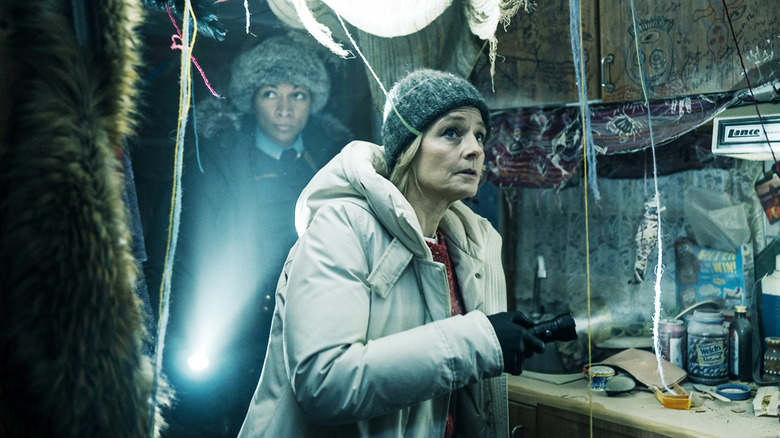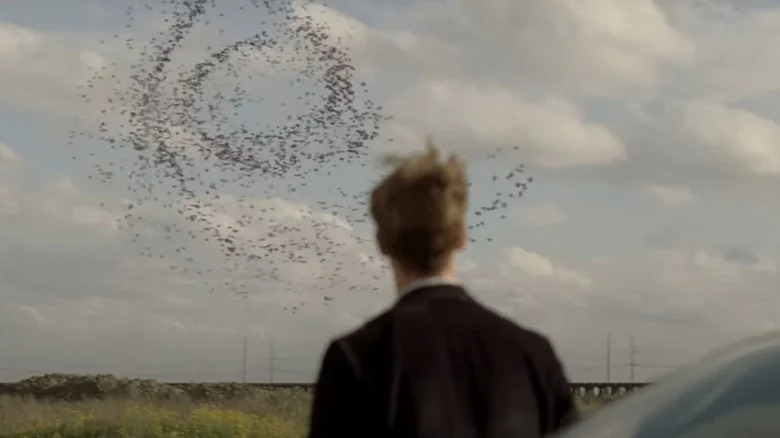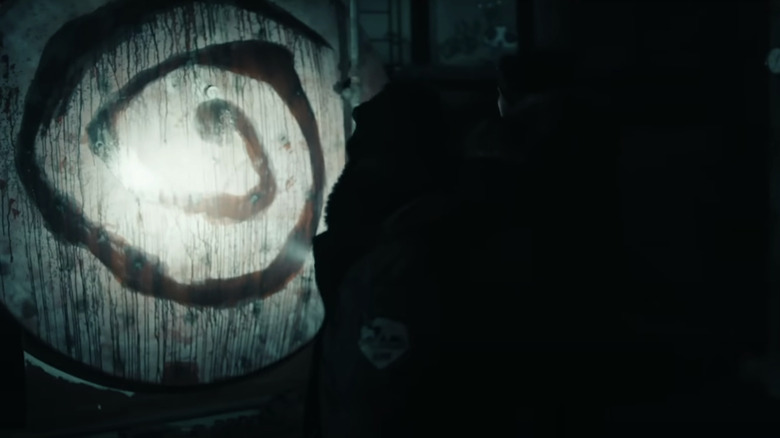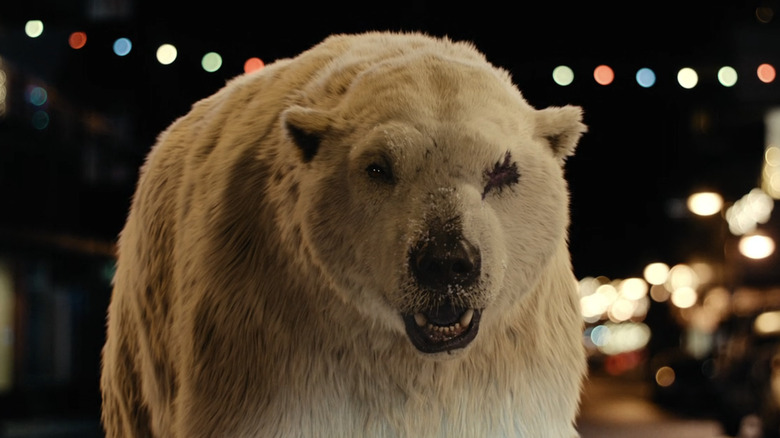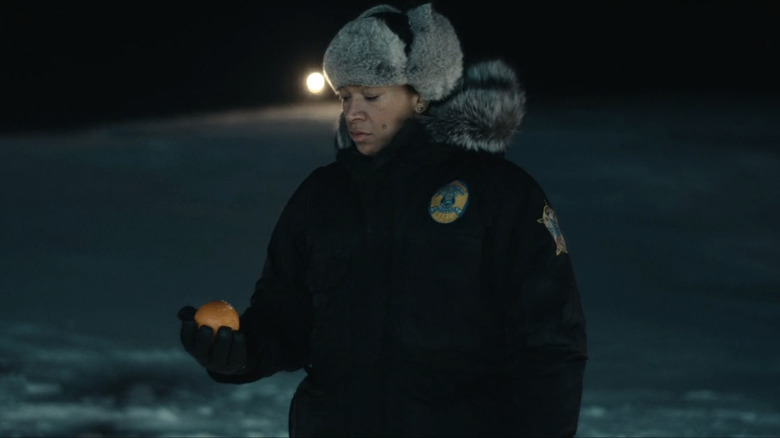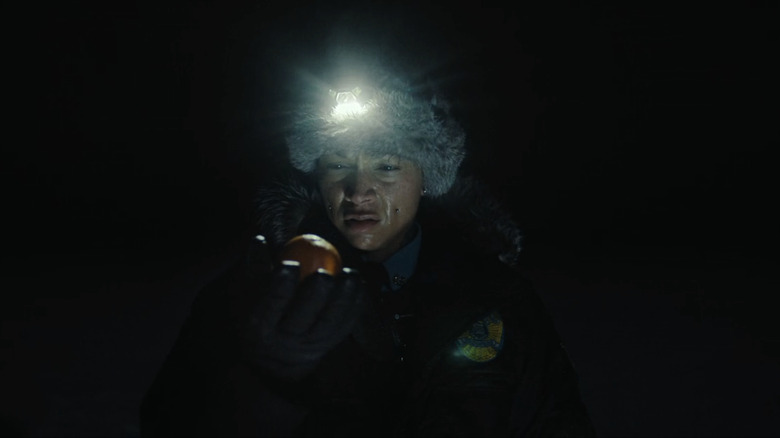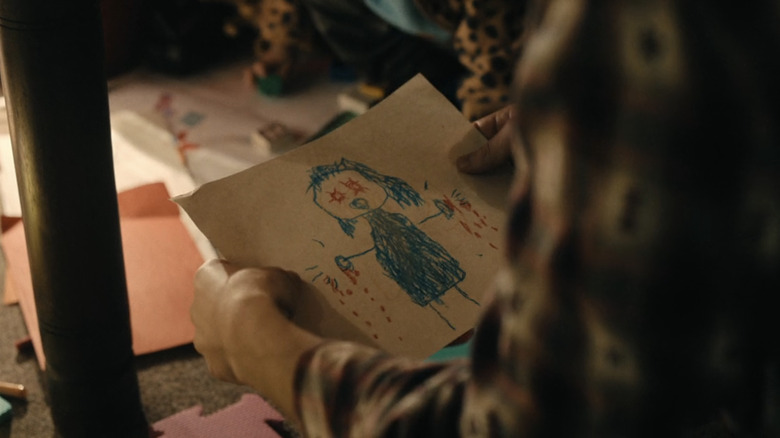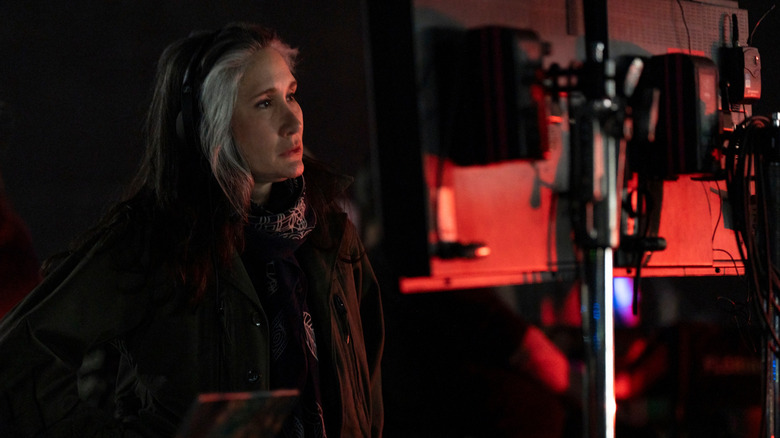All The Symbolism In True Detective: Night Country Explained
Spoilers follow.
"True Detective: Night Country" is a murder mystery. But the fourth season of the crime anthology series tells a deeper story, with new showrunner Issa López weaving a dense narrative full of symbolism and metaphor. So full of cryptic imagery is this season, that fans of the series will no doubt struggle to keep up with just what it all means, or whether it means anything at all.
Reintroducing elements from season 1 has been a big part of "Night Country," which, early in its run, confirmed it was a direct sequel to the original season. That means we've seen plenty of the ominous spiral symbol, which originated in the series pilot and represented the sinister Carcosa or Yellow King cult. In "Night Country," however, the spiral has played an even bigger role, with López seemingly set to reveal its origins by the end of her season.
But the spiral is just one part of the symbolism story. "Night Country" is full of similarly foreboding signs and figurative imagery, which alongside the central murder mystery, make López's season a very cryptic affair. Much of that is down to the showrunner wanting to straddle the line between supernatural horror and realism. As she told the official "Night Country" Podcast, "In a way, this show is a little bit like that first season in the sense that you can read it as an inkblot test that you can decide if you believe in a spiritual world." How López has chosen to represent that spiritual element makes for a truly fascinating aspect of "Night Country," even if it is a tad confusing for casual viewers. As such, allow us to explain what the heck all those spirals, one-eyed polar bears, and spooky citrus fruits mean.
The Spiral from True Detective season one
The spiral that appeared throughout the "Night Country" trailer? Turns out it's much more than an Easter egg for season one fans. In fact, season four's central mystery seems to be deeply associated in some way with this cryptic motif, which first appeared back in the pilot episode of season one. Initially seen tattooed on the back of murder victim Dora Lange, the spiral was later witnessed by Matthew McConaughey's detective Rustin Cohle in his post-drug visions.
While there was never any official explanation for the spiral, it at least in part represented the cult responsible for the ritual abuse and murder plaguing southern Louisiana at the time. It was also a physical manifestation of Rust's famous "time is a flat circle" philosophy of eternal recurrence, which was borrowed from Friedrich Nietzsche and essentially posited that life will repeat indefinitely with only slight aberrations.
Then, in season three, show creator Nic Pizzolatto resurrected the spiral for a brief scene in which documentary producer Elisa Montgomery (Sarah Gadon) shows state police detective Wayne Hays (Mahershala Ali) a document featuring a blue spiral and claims that it's "code for pedophiles." Otherwise, the origins of the spiral remained yet another unsolved mystery in the "True Detective" universe.
True Detective: Night Country reinterprets the spiral
In "Night Country," Issa López's season immediately signals an alternate interpretation of the spiral by literally flipping the symbol itself. The spiral from the first season unraveled anticlockwise from the center, while the reverse is true for the "Night Country" version. In episode five, a character claims the symbol — which isn't the only season one symbolism in "Night Country" — is used as a marker to warn people away from thin ice, seemingly providing a very practical explanation for its use.
But there's more to it than that. Flipping the spiral was seemingly intentional, with López speaking on the show's official podcast about how Ennis police chief Liz Danvers (Jodie Foster) and State Trooper Evangeline Navarro (Kali Reis) are "going deeper into this spiral, into the abyss" as they investigate the death of the Tsalal research center scientists. She continued:
"There's a reason that spirals are a warning. Interestingly, when you fall down a spiral you're also falling down to the center and sometimes falling all the way down to the center is what you need to find yourself so yes there is a lot of catastrophe happening here but it's the path to discovery."
In this sense, the spiral has much more positive connotations than the version from season one. Rather than signifying ritualistic child abuse rings and how the human race is doomed to eternally repeat its past actions, the symbol in "Night Country" at least in part represents this journey of self-discovery and spiraling down in order to rise again.
The significance of the one-eyed polar bear in True Detective: Night Country
The theme of having one eye is best exemplified by the one-eyed polar bear, first seen when Trooper Navarro encounters the creature while driving in episode one. Chief Danvers also has a stuffed toy version of the one-eyed polar bear that belonged to her deceased son, Holden. But that's not the only one-eyed symbolism in "Night Country." In episode one, Chief Danvers discovers a photo that shows their prime suspect, Raymond Clark (Owen McDonnell) wearing murder victim Annie Kowtok (Nivi Pedersen)'s jacket with a patch sewn over the shoulder tear. That patch depicts a winking smiley face — i.e. a face with one eye open. Then, there's Otis Heiss (Klaus Tange), a local who sustained similar injuries to the scientists decades before they died and who is blind in one eye as a result. Finally, there's Danvers' late son himself, who in flashbacks is shown playing a game with his mother where they cover one eye and tell each other "I see you."
On the official "Night Country" Podcast, Issa López talks about the "I see you game," explaining it as "a reference to the fact that we see only part of what is around you," adding, "It's a little bit of a metaphor." This connects to the central theme of "Night Country," i.e. the existence or non-existence of God and/or a spiritual realm. Danvers, in her dogged rationality, consistently denies the existence of both throughout the show, while Navarro is acutely aware of something beyond material existence. This tension between the two is expressed through several other motifs in "Night Country," but is most clearly represented by this one-eyed symbolism that suggests we're only seeing half the story when we deny the transcendent.
What does the Orange mean in True Detective: Night Country?
You didn't think Issa López was going to stop the symbolism at creepy spirals and one-eyed polar bears, did you? There's still a ton of imagery left to explain even after you've got your head around those two prominent motifs. For example, in episode three, Evangeline Navarro pockets an orange discarded by a member of the Raymond Clark search team, and later, while out on the ice, rolls the fruit into the darkness, only for it to roll back to her while a faint voice whispers, "Help us."
We later see this spooky fruit roll out from under a bed in The Lighthouse, the mental health facility where Navarro's sister, Julia (Aka Niviâna), stays prior to her death. When Julia takes a peek under the bed, she sees the body of a woman and a silver crucifix necklace, which is likely her mother, who we know based on Navarro's previous conversation with Eddie Qavvik (Joel D. Montgrand) was the victim of domestic abuse and was eventually murdered by an unknown killer.
So, what does the orange have to do with horrific murders and past trauma? Well, you might remember the significance of oranges in "The Godfather," where they were used as a symbol of impending death (at least, they were after director Francis Ford Coppola realized audiences were making the connection in "The Godfather" and doubled down on it for the two sequels). As Vulture notes, "This imagery has been so imprinted on the mainstream consciousness that the prominent placement of this delightful citrus fruit in any film or television scene immediately demands further scrutiny." Even "Breaking Bad" continued the oranges as a portent of death trope. But in "Night Country" things are more nuanced than that.
Oranges are more than a portent of death in Night Country
Rather than go the Coppola route and use oranges to foreshadow death, Issa López expands the symbolism so that the fruit represents a connection between the real world and the spiritual realm with which Navarro is so in tune. The orange rolling back to her on the ice represents the dead communicating with her from the beyond. This seems to be a fairly common occurrence in Ennis. As Fiona Shaw's Rose Agineau tells Trooper Navarro earlier in the season:
"The thing about the dead is that some of them come and visit because they miss you. Some come because they need to tell you something that you need to hear. And some of them just wanna take you with them."
In Navarro's case, the dead quite clearly know something that the State Trooper needs to hear. Julia, however, who commits suicide in episode four, appears to be one of those that the dead wanted to "take with them." In both cases, the orange becomes a connection between the living and the dead, rather than simply an ominous way to portend a character's demise. Again, this ties into the central theme of "Night Country": the tension between faith in the transcendent and a purely materialistic view of the universe. We'll explain how and why López is so fascinated by this tension and why it therefore pervades "Night Country" later. Suffice it to say that the series has, since the season one pilot, walked a line between gritty realism and supernatural horror, making Lopez and her personal experiences a perfect fit for the series.
Sedna in True Detective: Night Country
One of the "Night Country" theories suggests a local legend come to life is to blame for the happenings in Ennis — specifically, the Inuit creation myth of Sedna, a girl who became a goddess after she was thrown into the ocean by her father. In some tellings of the story, Sedna's father cuts off her fingers, which then become sea creatures. Early in "Night Country," police officer Peter Prior (Finn Bennett) discovers that his infant son, Darwin, has drawn a blue female figure with blood dripping from her severed fingers and Issa López has confirmed that this drawing does indeed represent Sedna.
As /Film's Valerie Ettenhoffer points out, Kimberley McMahon-Coleman's 2006 piece "Dreaming an Identity Between Two Cultures" explains that, in the legend, "All the animals of the land and sea originate with [Sedna], and if she is angered, starvation will surely follow." "Night Country" features a controversial mine that's thought to be polluting Ennis in some horrible way and characters have been hearing the mysterious phrase, "She's awake" at various points, calling to mind the vengeful nature of this Inuit protector of the natural environment.
Could this mean "Night Country" will fulfill the cosmic horror promises of season 1 and reveal a supernatural explanation for the events in Ennis? Perhaps. Or perhaps the use of Sedna is more metaphorical and represents the people of Ennis fighting back against the mine polluting their town? Or maybe Sedna represents the women of Ennis as a whole, some of whom are domestic violence victims, and in Annie K's case, murder victims. Navarro's mother, as we know, was also killed by an unknown assailant. In that sense, Sedna could be a way for López to represent the spirit of the women of Ennis.
What does all the symbolism in Night Country ultimately mean?
To understand "Night Country," you just need to look to Issa López and her personal experience. The showrunner has spoken about growing up with a Catholic, superstitious mother and an atheist, communist father, which gave rise to a unique tension in herself. As she told the "Night Country" Podcast:
"Danvers and Navaro, Mom and Dad, God and the absence of God live in me and I think that they live in all of us. We have moments of faith when we're believers, at times we lose our faith when we are nonbelievers, at times we're tempted to pray and to believe. And I think that the fluctuation of these two are at the center of who we are. So finding a line that can walk both at the end of the series is part of the mission."
The rich imagery and metaphor in "Night Country" speaks to this central tension between a view of existence as supervised by God and a view of existence that refutes the very idea of the transcendent. That's the idea from which all these symbols and metaphors flow — the spiral and its reinterpretation as a symbol of self-discovery, the one-eyed polar bear representing our inability to see the spiritual realm, the orange being a connection between our world and the world of the dead. Even the remote Alaskan setting where, as Rose Agineau puts it, "the fabric of all things is coming apart at the seams," is the perfect place to explore this "line that can walk both" the spiritual and rational without confirming either as the ultimate truth. In that sense, though López's season concerns itself with some very real and specific social issues, it's ultimately getting at something truly universal.
